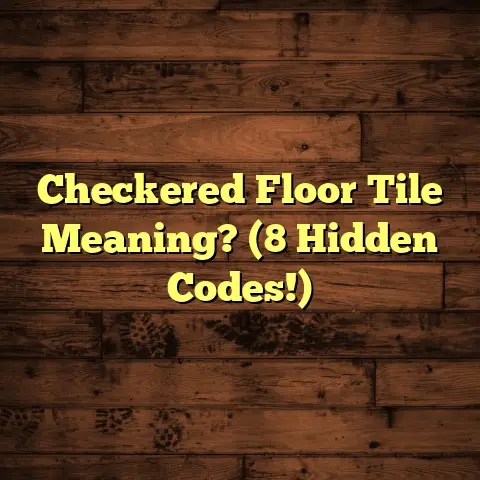Laying Self-Adhesive Tiles On Concrete (5 Prep Mistakes!)
It’s your friendly neighborhood flooring contractor, here to talk about a popular choice for quick and easy floor upgrades: self-adhesive tiles.
I’ve laid down countless floors in my career, and let me tell you, self-adhesive tiles can be a game-changer.
But, like any flooring project, success hinges on proper preparation.
Trust me, I’ve seen it all – from tiles peeling up within weeks to floors that look more like a patchwork quilt than a smooth surface.
The culprit? Almost always, it boils down to skipping crucial prep steps.
So, let’s dive into the world of self-adhesive tiles and concrete subfloors, and I’ll share the five most common mistakes I see homeowners make.
Avoiding these pitfalls will save you time, money, and a whole lot of frustration. Ready? Let’s get to it!
Introduction: The Unique Material of Self-Adhesive Tiles
Self-adhesive tiles have really taken off in recent years, and for good reason.
They offer a fantastic blend of affordability, ease of installation, and a surprisingly wide range of styles.
Think of them as thin, durable sheets – usually made from vinyl or PVC – that come with a pre-applied, super-sticky adhesive backing.
This adhesive is designed to create a strong bond with your subfloor, making installation a breeze compared to traditional tile or hardwood.
What I love about these tiles is their versatility.
You can find them in countless colors, patterns, and textures, mimicking everything from natural stone to wood grain.
Plus, innovative manufacturing techniques have made them incredibly moisture-resistant.
This makes them a solid choice for kitchens, bathrooms, basements, and just about any room in your home or even light-commercial spaces.
But don’t let the “easy install” fool you.
While self-adhesive tiles are definitely DIY-friendly, they’re not magic.
A little preparation goes a long way in ensuring a beautiful, long-lasting floor.
Section 1: Understanding the Concrete Subfloor
Now, let’s talk about concrete.
As a flooring contractor, I’ve worked with concrete subfloors more times than I can count.
It’s a popular choice because it provides a stable, durable foundation for all types of flooring.
However, concrete isn’t without its quirks.
While it’s strong, it can also be porous, meaning it can absorb and retain moisture.
It’s also prone to developing cracks, uneven spots, and a layer of surface dust.
These characteristics can pose challenges when installing self-adhesive tiles.
Think of it this way: you’re trying to stick something to a surface that might be damp, dusty, or bumpy.
Not exactly a recipe for success, right?
That’s why assessing the condition of your concrete subfloor is absolutely critical before you even think about laying down a single tile.
Proper preparation is the key to a successful installation, and it all starts with understanding the unique properties of concrete.
Section 2: Common Prep Mistakes to Avoid
Alright, let’s get to the heart of the matter: the five common preparation mistakes that can ruin your self-adhesive tile project.
I’ve seen these mistakes time and time again, and trust me, they’re easily avoidable with a little knowledge and effort.
So, pay close attention, take notes, and let’s make sure your new floor looks fantastic for years to come!
1. Neglecting Surface Cleaning
This might seem obvious, but you’d be surprised how many people skip this crucial step!
Think of your concrete subfloor as a magnet for dirt, dust, grease, and even old adhesive residue.
These contaminants create a barrier between the tile’s adhesive and the concrete, preventing a proper bond.
Imagine trying to tape something to a dusty window – it’s just not going to stick, right?
The same principle applies here.
Even if the concrete looks clean to the naked eye, there’s likely a layer of fine dust and grime that you need to remove.
How to fix it:
- Sweep Thoroughly: Start by sweeping the entire area with a stiff-bristled broom to remove loose debris.
- Vacuum: Follow up with a vacuum cleaner, preferably one with a HEPA filter, to suck up any remaining dust particles.
- Scrub with a Cleaner: Use a mild detergent or a specialized concrete cleaner mixed with water.
- Scrub the floor thoroughly with a scrub brush or mop.
- Rinse and Dry: Rinse the floor with clean water to remove any soap residue.
- Allow the floor to dry completely before proceeding to the next step.
For stubborn grease or adhesive residue, you might need to use a solvent-based cleaner.
Always follow the manufacturer’s instructions and ensure proper ventilation when using these products.
Pro Tip: I often recommend using a TSP (trisodium phosphate) solution for cleaning concrete. It’s a powerful degreaser and cleaner, but be sure to wear gloves and eye protection when handling it.
2. Ignoring Moisture Issues
Moisture is the silent killer of self-adhesive tile installations.
Concrete is porous, and it can absorb moisture from the ground, the air, or even from spills.
If you install self-adhesive tiles over damp concrete, that moisture will eventually cause the adhesive to fail.
This can lead to tiles warping, bubbling, or even developing mold and mildew underneath. Yuck!
Moisture issues are especially common in basements or on concrete slabs that are in direct contact with the ground.
How to fix it:
-
Moisture Testing: The first step is to test the moisture levels in your concrete. There are several methods you can use:
- Calcium Chloride Test: This is the most accurate method.
- It involves placing a small container of calcium chloride on the concrete, sealing it with a plastic dome, and measuring the amount of moisture absorbed over a specific period.
- This test usually costs around $20-$50 and gives you a precise reading of the moisture vapor emission rate (MVER).
- Plastic Sheet Test: This is a simpler, less accurate method. Tape a 2×2 foot square of clear plastic sheeting to the concrete floor and seal all the edges with tape.
- Leave it in place for 24-72 hours.
- If you see condensation forming under the plastic, it indicates that there’s excessive moisture in the concrete.
- Moisture Meter: Electronic moisture meters can provide a quick and easy way to assess moisture levels.
- However, they’re not as accurate as the calcium chloride test.
-
Addressing Moisture: If your moisture test reveals excessive moisture, you’ll need to address the issue before installing your tiles.
- Seal the Concrete: Apply a concrete sealer specifically designed to block moisture.
- These sealers penetrate the concrete and create a waterproof barrier.
- Install a Moisture Barrier: In severe cases, you might need to install a physical moisture barrier, such as a polyethylene membrane, over the concrete.
Industry Insight: According to the Concrete Foundations Association, a concrete slab should have a moisture vapor emission rate (MVER) of no more than 3 pounds per 1,000 square feet per 24 hours for most flooring adhesives to bond properly.
3. Overlooking Floor Leveling
Self-adhesive tiles are thin and flexible, which means they’ll conform to the shape of the subfloor beneath them.
If your concrete subfloor is uneven, cracked, or has noticeable bumps, those imperfections will show through the tiles.
This not only looks bad but can also weaken the adhesive bond and cause the tiles to crack or lift over time.
Think of it like trying to wallpaper a wall with lots of holes and dents – the wallpaper will just accentuate those flaws.
How to fix it:
- Inspect the Floor: Carefully inspect the concrete floor for any cracks, holes, or uneven spots.
- Use a level or a straightedge to identify high and low points.
- Fill Cracks and Holes: Use a concrete patching compound to fill any cracks or holes in the floor.
- Follow the manufacturer’s instructions for mixing and applying the compound.
- Allow it to dry completely before sanding it smooth.
- Level Uneven Areas: For larger uneven areas, you might need to use a self-leveling concrete compound.
- This is a pourable mixture that spreads out and levels itself, creating a smooth, even surface.
- Follow the manufacturer’s instructions carefully, as self-leveling compounds can be tricky to work with.
- Sand Smooth: Once the patching compound or self-leveling compound is dry, sand the entire floor smooth with a concrete grinder or a sanding block.
- This will ensure a consistent surface for the tiles to adhere to.
Personal Experience: I once worked on a project where the homeowner insisted on skipping the leveling step. Within a few months, the tiles started cracking and lifting in several areas. They ended up having to tear up the entire floor and start over, costing them a lot more time and money. Learn from their mistake!
4. Failing to Acclimate Tiles
This is a step that many people overlook, but it’s crucial for ensuring a successful installation.
Self-adhesive tiles are sensitive to temperature and humidity.
When they’re exposed to different conditions, they can expand or contract slightly.
If you install tiles that are too cold or too warm, they might shrink or expand after installation, creating gaps or buckling.
How to fix it:
- Bring Tiles Indoors: Bring the self-adhesive tiles into the room where they’ll be installed at least 48-72 hours before you plan to start the project.
- Maintain Room Temperature: Ensure that the room is at a consistent temperature, ideally between 65°F and 75°F (18°C and 24°C).
- Stack Loosely: Stack the tiles loosely, allowing air to circulate around them.
Why it Matters: Acclimating the tiles allows them to adjust to the room’s temperature and humidity, preventing any unexpected expansion or contraction after installation.
5. Skipping the Layout Planning
Jumping right into laying tiles without a plan is a recipe for disaster.
Proper layout planning is essential for achieving a professional-looking floor and minimizing waste.
Without a plan, you might end up with awkward cuts, uneven borders, or tiles that don’t align properly.
How to fix it:
- Measure the Room: Accurately measure the length and width of the room.
- Determine the Center: Find the center of the room by marking the midpoint of each wall and drawing intersecting lines.
- Dry Lay Tiles: Before removing the adhesive backing, dry-lay a row of tiles along each of the center lines.
- This will help you visualize the layout and identify any potential issues.
- Adjust as Needed: If the tiles don’t align properly or if you end up with small slivers of tile along the edges, adjust the starting point or the center lines until you achieve a balanced look.
- Mark Guidelines: Once you’re satisfied with the layout, use a chalk line or a straightedge to mark guidelines on the floor.
- These guidelines will help you keep the tiles aligned as you install them.
Real-World Example: I once saw a homeowner who didn’t bother with layout planning. They started laying tiles in one corner of the room and worked their way across. When they got to the opposite wall, they realized that they were off by several inches, resulting in a very crooked and unprofessional-looking floor.
Section 3: Conclusion
So, there you have it – the five common preparation mistakes that can derail your self-adhesive tile project.
Remember, taking the time to properly prepare your concrete subfloor is the key to achieving a beautiful, long-lasting floor.
Don’t skip the cleaning, moisture testing, leveling, acclimation, or layout planning.
By avoiding these pitfalls, you’ll save yourself time, money, and a whole lot of frustration.
Now go forth and create the floor of your dreams!
And remember, if you’re ever feeling overwhelmed, don’t hesitate to call a professional like myself. I’m always happy to help!





